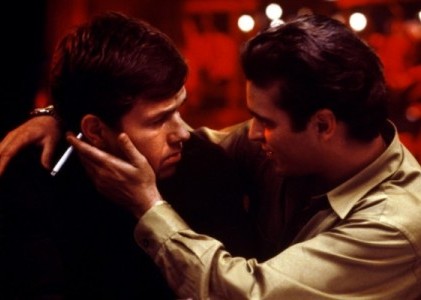Train Spotting
The following is an excerpt from a chapter on The Yards in James Gray, by Jordan Mintzer, which also includes interviews with the actors Mark Wahlberg and James Caan, the co-writer Matt Reeves, the d.p. Harris Savides and the composer Howard Shore. The book is available for purchase on the French publisher's website (www.synecdoche.fr) and in select bookstores in the U.S. and throughout France. The Yards will be shown on December 15 at 7 p.m. at the Museum of the Moving Image, and the screening will be followed by a Pinewood Dialogue with Gray and a book signing with Gray and Mintzer.
Over the course of the week-long discussion that was the basis for the book James Gray, perhaps the most difficult film to tackle was The Yards. Not only did Gray have a less than fond memory of dealing with the Weinsteins during the movie's troubled post-production period, as well as of the lukewarm reception The Yards received for its world premiere at the 2000 Cannes Film Festival. When it actually came down to analyzing specific scenes, he didn't remember shooting some of them at all. It was thus necessary—to quote Warner Wolf—to go to the videotape, which in this case was a Blu-ray of the film sitting in James's closet, still in its plastic wrapper. "As you can see," he cracked, "I never watch my own movies."
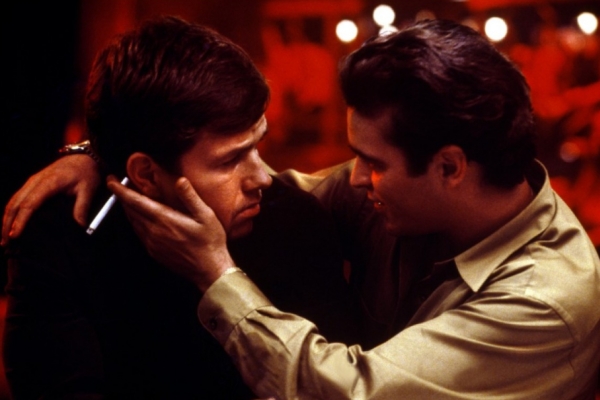
Mark Wahlberg and Joaquin Phoenix in The Yards
It's an exciting experience to sit with a filmmaker as he rediscovers a work, however recent, that's been somewhat forgotten, and while Gray did have a hard time recalling certain things in The Yards (particularly one of my favorite moments: the near-silent, impeccably choreographed scene where Raymond Price [Andrew Davoli] tries to kill Leo [Mark Wahlberg] in his living room), he seemed to take pleasure in the performances of a very young Wahlberg and Joaquin Phoenix, and in revisiting the chiaroscuro textures of Harris Savides's Anamorphic lensing. That, and some of the film's more memorable scenes—the raw street fight between Wahlberg and Phoenix, the club scene where Charlize Theron is tossed around like a rag doll to the cheesy beats of "Samba de Janeiro"—were met with waves of James's hearty laughter (which, according to many of his collaborators, is a sign that he likes what he's seeing).
If The Yards was largely neglected by U.S. critics and audiences when it opened in the fall of 2000, this seemed at least partially because Miramax didn't think it had the legs to take it all the way to the Oscars, and partially because in a post-Pulp Fiction world, a crime movie without irony or funk music was not à l'ordre du jour. Yet like many a great film that was not revered upon release, it's perhaps easier with hindsight to see how The Yards is very much the cornerstone of Gray's cinema, melding autobiographical details into an emotional fresco-cum-genre piece tackling corruption and class envy in one of the city's least filmed boroughs. You could call it the ultimate Queens film. The film's setting is surely one of the keys to its grandeur: only in a world so close to Manhattan, yet ever so far, could a movie about warring subway contractors take on the scope and intensity of a Viscontian epic.
While you were wrapping Little Odessa, were you already beginning to work on other projects?
I didn't know what I wanted to do just yet. But then, sometime after the film premiered in Venice, I began working on The Yards.
It seems like you tend to work on one movie at a time, that you're not the type of director who has four or five projects going on at once.
I have one project and I obsess over it, and then try to get it made for as long as it takes. And that's why it sometimes takes so long for me between movies.
How much time passed between Little Odessa and The Yards?
I shot it four years after I shot Little Odessa. It took another year to finish, and then, by the time it came out, it was another year after that. All in all, it was released five years after Little Odessa. That's not too bad.
Like in Little Odessa, you used certain autobiographical elements in The Yards.
Very much so, but in The Yards, my ambition was a little different. I was trying to tackle a couple of different things, one of which was how corruption and violence are the central organizing principles of society. I was also anxious to show a kind of ersatz family—one that had tried to reconstruct itself and was held together partly by class envy, and then is ultimately destroyed by corruption.
In a way, it was a mistake to do it, because it's a subject fit for a Russian novel. Narratively speaking, it took a long time to establish all of the connections between the characters. Having said that, in some ways The Yards is my favorite of my movies, even though it's my least successful movie on every level: worst reviewed, worst box office, and the most difficult to cut together. Perhaps as a consequence, I like it the most.
You mentioned that Robert Caro's book The Power Broker: Robert Moses and the Fall of New York was also an inspiration for the script.
We talked about Robert Moses a lot while preparing the movie, especially in terms of production design. I was trying to capture a New York that doesn't exist anymore, and that, at the time, was on its way out. I kept calling it the clash between an Archie Bunker-type New York and a New York of small-time rich guys.
I remember that a big thought that I had was about the pressure of conformity, the need to feel like you fit into a larger system as a means to combat your loneliness. And I tried to put that into a story about how New York was deindustrializing, and how people like Frank Olchin (James Caan) were a dying breed.
Mark Wahlberg's character also tries to find his place in the system.
Everybody tries to find a place: James Caan's character bought his new family and wears it like a cloak of respectability; Mark Wahlberg's character wants to be part of that family at large and fit into society, and says as much to his mother (Ellen Burstyn); Joaquin Phoenix's character wants to fit into that family because he's different, and wants to be a part of it whatever way he can; and Faye Dunaway's character is aspiring to ascend the class ranks.
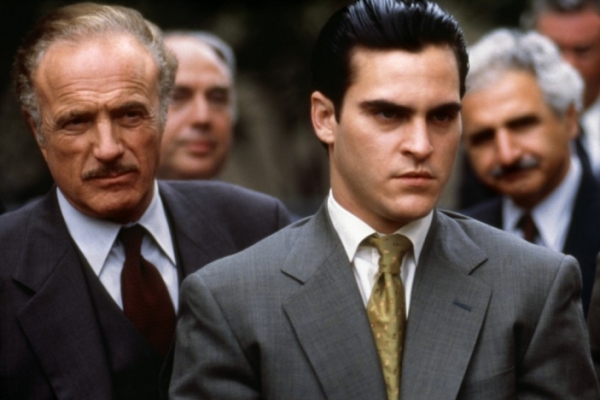
James Caan and Joaquin Phoenix in The Yards
Compared to a lot of American films, The Yards is extremely frontal about the class issues of its characters.
I was very conscious of that, and really wanted to make a movie about social class in New York. I thought it wasn't something that people talked about very much.
It seems that Hollywood films in general have lost the urge to deal with class issues.
They've lost it completely. And even if they deal with class in a certain sense, they still adhere to the rules of the American dream.
Which is something your films do not embrace.
No—in a way they are about that being bullshit, because I believe that the American dream is a myth. That doesn't mean there's no way you can escape your class, but that social class plays a major role in how our lives unfold. I don't think I can name one great movie where it doesn't function. Perhaps 2001, though I'm sure we can manufacture some reading about social class into that movie too.
Your films all depict New York City in a very class-oriented way: the characters live in blue collar neighborhoods in Brooklyn and Queens, and have almost no access to the riches of Manhattan. They're cut off from that.
Well that was very much part of my life as a youngster. We lived in Queens, and Manhattan was like another universe.
The New York of the outer boroughs is rarely shown in Hollywood movies. It's always the same glittering Manhattan skyline.
Right—it's like Woody Allen's Manhattan done incompetently, because in Manhattan he has an awareness that the vision is romanticized and bogus. And in a way the whole movie is about people's neuroses, and how the beauty of Manhattan is only a sad and ridiculous surface.
Movies about New York seemed to have evolved along with the city itself, so that since Manhattan has now become such an expensive place to live, most films about New York only deal with the rich.
It's because Manhattan has become an island for incredibly wealthy people. There is no Rear Window, with Jimmy Stewart as a middle class photographer living in the Village. That's gone—it left in the early-to-mid '80s. Even on television, they used to depict class very boldly, and in its early years, All in the Family offered a very unsentimental and unflinching approach to such issues. But that's not so present anymore. The Harper's Index recently had a figure which said that the average family of four depicted on television in 1955, adjusted for inflation, earned about $60,000 a year. While the average family of four depicted on television this year earned around $280,000. They're selling you the lie, because it's all about advertisement. The richer they can make the family seem, the more palatable they think it will be for the public.
What are some of the New York movies that you do like?
As a kid the one that really struck me was The French Connection because, to me, it depicted New York as a giant garbage can. It had never been shown that way in a movie before. Before then, most movies about New York had been focused on the glamour.
There's some unbelievable location shooting in The French Connection.
That was a product of the late '60s and early '70s, when Mayor Lindsay made it much easier to shoot in New York. It's also a movie that hasn't aged poorly, mostly because of Gene Hackman's investment in his character, which is quite superb. But in terms of outer borough films, there's really nothing.
Goodfellas is a pretty good outer borough film.
It is, and there's some Queens stuff in it. But it wasn't the New York I knew, because I didn't know funny Italian mobsters. By the way, did you know that Marty Scorsese is from Flushing? He moved back to Little Italy when he was around ten. I once asked him how growing up in Flushing was, and he said [imitating Scorsese]: "It was fantastic, it was like paradise!" I said, "Flushing was paradise?" "Yeah," he said, "I'd ride my bike around and stuff..." Flushing for me was not paradise.
From what I understand, the story of corruption in The Yards is partially based on truth.
It's what I had heard about my dad's business—stuff like officials getting naked to see if the other guy is wearing a wire. I remember at the time some people said to me that the movie strained credulity. I never really understood why, because very little in it is made up.
The script is extremely detailed in that sense. You see contractors bidding for contracts at Borough Hall, as well as other minute aspects of the contracting business.
I know, and it's extremely unsexy! In a way it was insanity on my part to think that it had any commercial value at all, and it's amazing I got it made. It's a product of Harvey Weinstein being crazy, but in a great way.
Was the writing process on The Yards similar to that of Little Odessa?
It was much more difficult because the project's ambitions were different. Matt Reeves came to help me after the first couple of drafts, because I really couldn't get the structure together. The actual screenplay is different from the movie, and it had five separate points of view on what happened in the subway yards.
It was more of a Rashomon-style narrative?
Yes, but when I cut the picture together I realized that it didn't quite work. It worked much better as a straightforward narrative, so I refashioned it around Mark Wahlberg's point of view.
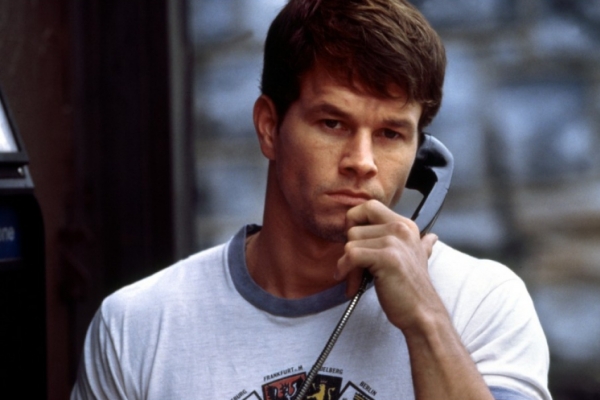
Mark Wahlberg in The Yards
Compared to your other films, there's also a much more macro vision of society in The Yards. We see all the different strata, from the politicians down to the lowest level maintenance workers.
It was especially difficult to do that in a movie that would be less than three hours.
Why? Did the producers put a time constraint on the cut?
Not at all. But I remember thinking that three hours was not practical, especially because I was already dealing with a commerciality issue in trying to make a movie about subway parts!
Were the actors attached very early on in the pre-production process?
No, and it was very difficult to get a cast. I remember that we were with Sean Penn and Bob De Niro for a while. Then we had a reading and Bob decided that he didn't want to do it, and Sean followed suit. But these movies happen for a reason, and you wind up finding the right cast to do it. For instance, Sean wouldn't have been right—he was already too old to play Leo Handler, which meant I would have to rewrite the movie for him.
What did you do in that case?
After Bob and Sean decided not to do it, I went into a bit of a funk. Then Mark Wahlberg's agent contacted me, and Paul Thomas Anderson kept telling me, "Mark is someone you should look at." So I went to his editing room and Paul showed me some scenes from Boogie Nights. It wasn't really what I was after, but it was certainly interesting. For Joaquin Phoenix, I had seen him in To Die For and thought he was a very interesting actor. So I went after him.
Once I had Mark and Joaquin, Charlize Theron came to me, and she'd never done anything. I thought she was a blond bombshell and totally wrong for the part. But when she arrived at the audition, she looked the way she looked in the movie, with dark hair and too much mascara. I didn't recognize her and said, "Are you Charlize's assistant?" She said, "No, I'm Charlize!" She was so passionate—I loved it.
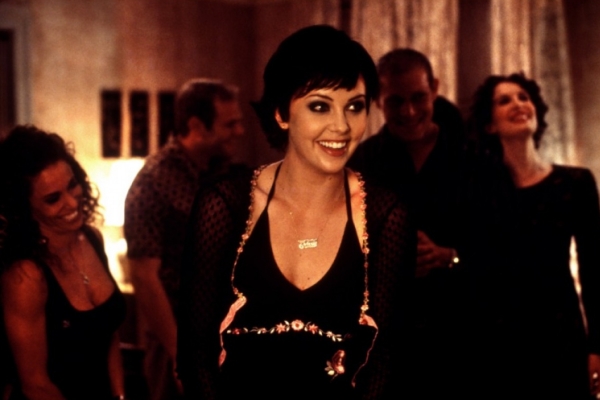
Charlize Theron in The Yards
How about the older cast members?
The elder statesmen actors were all people I wanted to do the movie with. Originally, I went to Ann-Margret for Faye Dunaway's part. I had a meeting with her because I thought she would've been great. But Harvey Weinstein said no for reasons I don't quite understand. For Leo Handler's mother, I wanted either Ellen Burstyn or Gena Rowlands, and I wound up getting Ellen.
Since The Yards had an even larger cast than Little Odessa, did you need to do more rehearsals this time around?
We had some rehearsal time, but again not much. We read through the scenes with the actors, which was quite fun. I remember being completely in awe of the elder statesmen. Jim Caan is such a terrific actor, and in a way he's underrated because everyone just thinks he's Sonny Corleone, which he's not. But his performance in The Godfather is so good that people think that's who he is. He's also brilliant in Michael Mann's Thief, which has one of the greatest acting scenes ever when he's talking about being raped in prison. And he's amazing in Karel Reisz's The Gambler.
In terms of the production, The Yards was a more ambitious project, which I imagine required a much bigger shoot.
It was much bigger, and it was the most time I've ever had to make a film. I had something like fifty-nine days to shoot it, so we really focused on the lighting. To see a print of the film is really great because of all the beautiful work of Harris Savides.
Did you and Savides screen certain films together in preparation for the shoot?
We watched all the working class pictures—especially those set in New York—that we possibly could. We screened On the Waterfront and Rocco and His Brothers, which was a big one for us. And of course we screened The Godfather and The Godfather: Part II to see how they looked. In a way that might have been a mistake, because at the time people said to me, "The Yards is like The Godfather." But the story of The Godfather has nothing to do with The Yards at all. It just looks like it, and also has James Caan sitting in a dark wood room.
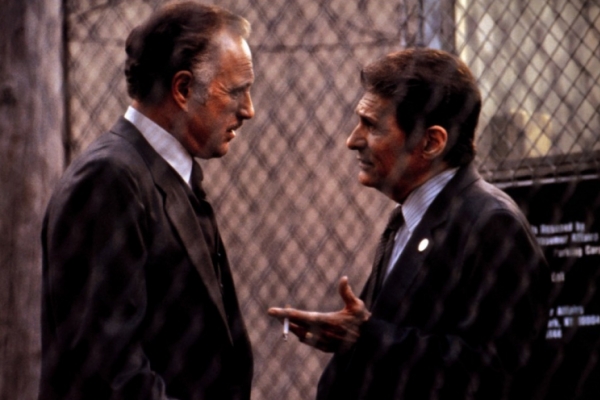
James Caan and Tony Musante in The Yards
The film uses widescreen framing in a very grandiose way. It was shot on Anamorphic, correct?
It was shot on Anamorphic with Panavision C-series lenses, which were old lenses. They were very slow, and the depth of field was awful. For instance, in the opening party scene we shot with real candlelight, and when Ellen Burstyn moved her head only slightly she'd be out of focus, so we would have to do another take. Overall, it took a long time to shoot because the lighting in the entire film is ridiculously precise. It's like Gordon Willis on steroids!
It's funny you mentioned Rocco and His Brothers, because the fight scene which happens in the middle of The Yards always reminded me of one in the Visconti film between Alain Delon and Renato Salvatori, when they're boxing in the street.
It's totally ripped off from that. What I tried to do was make the fight scene in Rocco, except do it more realistically. I wanted a messy street fight that would just look awful. The two of them really went at it, and they're great. I'm sure there are many things in the films I've done that if I went back and watched them, I'd really cringe at and regret. But I think that scene is the best piece of film I've done so far.
Was the fight choreographed?
No. The stunt coordinator came up to them and said, "You throw a punch here. And you duck here." But I remember looking at Joaquin and Mark, and seeing that they were not listening at all. I set up three cameras up and down the street, and I called "Action!" They both had kneepads and elbow pads under their clothing, and they just started going at it! It was horrendous to look at.
What's interesting is that it's extremely realistic, but at the same time they're framed in an increasingly distant way so that, by the end, they're both isolated within the empty street.
The whole idea of it was that they were really powerless to act, that they were beating each other up but that their environment had as much to say about their lives as they did. Their ability to choose is dictated by the culture and the society at large. The point of the sequence is not the punching, but to present two guys who were warring against each other, and doing so because of forces out of their control.
How was it working with Mark Wahlberg for the first time?
I gave him line readings. He was really good, but he wanted line readings. He would say [imitating Wahlberg], "James, just tell me how to say it and I'll do it."
How about Joaquin Phoenix, who you would use in your next two films as well?
His acting style changed a lot from this film to the next one. On The Yards he did a lot of takes—he was lightning in a bottle. There wasn't necessarily a lot of thought put into what he was doing. When I worked with him on We Own the Night, he was extremely precise, very focused.
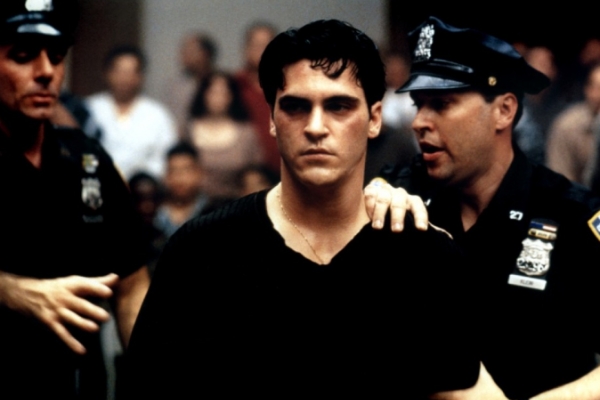
Joaquin Phoenix in The Yards
You once said that, "Every movie presents its own set of problems, its own set of rules." What were some of the problems presented by The Yards?
The problems were that you had multiple characters that were not necessarily connected by family, or they were, but only tenuously. Also, the story was about train parts, which is not a world anybody understands, so there was a lot of exposition that needed to be gotten out of the way. And there were point of view issues, because the story really had to be told through Mark Wahlberg's character, but he leaves the movie for a certain stretch of time. So it was necessary to always keep him part of the discussion.
In terms of scoring, on Little Odessa you had used a soundtrack of pre-existing music, whereas The Yards uses both pre-existing music and original compositions. How did you wind up working with a composer like Howard Shore?
Initially, I had wanted to re-record large sections of opera, but omitting the vocal score, and to have that used as the music in the film. My plan was to record the music before the film was shot, and then shoot it to the music. But it would have cost about $1 million to do that, and the studio did not feel really good about spending that kind of money up front.
When I finished the film, I said to myself, "God, I wish I had Nino Rota, but he's a little bit dead." So I believe Howard Shore was the studio's suggestion, and when I met him I loved him and thought he was a terrific man. A lot of the music ideas come from Gustav Holst's The Planets, which Howard adapted and stole some of the motifs and orchestrations from. When he was done, he played the entire score for me on piano and harp, and we talked through each piece together. I would tell him to take a certain melody and expand it, because what I basically wanted was for two themes to be repeated throughout the film. I did the same thing for We Own the Night.
The influence of Italian opera is very apparent in the music, as well as in the overall mood of the film.
I was very into the Verismo tradition—Emile Zola, Puccini, Mascagni, and those guys. The Verismo idea was that stories could be about anyone or anything, as long as they were treated with complete compassion. And, at the time, I was very interested in doing a working class epic, one without royalty.
But I don't know if that's such a good idea now. Aristotle said that every good story is about a king, and he knew what he was talking about. So I think that one of the flaws in the picture is that there's no archetypal hero. I don't mean a hero in the bad Hollywood sense where he wins everything, but in the sense of the journey of a mythic hero. The Yards doesn't really have that—it doesn't have a person accomplish anything.
It's interesting you say that because, in the cut that was released in theaters, Mark Wahlberg's character does accomplish something in the end when he denounces the corruption of James Caan and the other city officials.
That ending was forced on the movie by Harvey Weinstein. We reshot it one year later, with Mark wearing a wig because his hair had changed. The director's cut ends correctly when it dissolves from the funeral to the shot of Mark Wahlberg on the train.
Why did Harvey Weinstein force you to change the ending?
He said that the original ending didn't work, that it was too dark. I had wanted reshoots for other stuff that I had run out of time to do, but which I thought would make the film work better. To hold me ransom, he said, "Alright, but you give me that ending!" So I did it, and I will never do that again.
Did you write that additional scene yourself?
Matt Reeves and I wrote it, and tried to make it work as best as we could.
And then Miramax only released that version of the movie?
They did, because back then I didn't have final cut, which I do now. I was pretty powerless, and went to Cannes with their ending, where it got booed and received bad reviews. I remember being very depressed about it because I had worked very hard on the picture, and I was pleased with it except for the ending. And then everyone talked about the last minute sucking, and the whole movie sucking as a consequence.
Many people I know didn't see The Yards in theaters, but then saw it later on DVD, and found that it was really underappreciated when it was released. In that respect, it's become a sort of cult film.
Well, I've actually had some positive things sent to me over the last couple of years, including an article in Cinema Scope saying that The Yards was one of the best American films of the '90s. So I'm gratified that at least some people seem to have responded to the picture. ![]()
LATEST ARTICLES
-20140814-173707-thumb3.jpg)
Fighting Words
by Imogen Sara Smith
posted August 12, 2014

Fighting Words, Part 2
by Imogen Sara Smith
posted August 20, 2014

On the Margins: The Fil…
by Andrew Chan
posted August 12, 2014

Robin Williams: A Sense…
by David Schwartz
posted August 12, 2014
 Train Spotting
Train Spotting
KEYWORDS
interview | James Gray | The Yards | Museum of the Moving Image | Harris Savides | New York | social classes | Hollywood | audience reception | director’s cutTHE AUTHOR
Jordan Mintzer is a film critic for The Hollywood Reporter. Prior to that he worked for Variety. He is the producer of Matt Porterfield's Hamilton and Putty Hill and the author of James Gray (Synecdoche, 2011).
More articles by Jordan Mintzer
